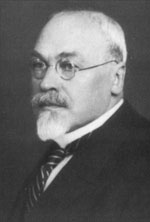Gustavs Zemgals
Gustavs Zemgals (born August 12, 1871 in the rural community Džūkste, today Tukuma Novads , Tukums County, Latvia ; † January 6, 1939 in Rīga ) was a Latvian politician and the second president of Latvia.
Life
After attending the primary school in Saka, Zemgals went to the Nikolai high school in Riga. In 1899 he graduated from Moscow University with a law degree . He returned to Latvia, became a lawyer and newspaper editor, and was involved in politics.
In 1904, during the Russo-Japanese War , Zemgals was called up to the front, where he stayed for a year and a half and was promoted to captain . Returned to Latvia in 1905, Zemgals was one of the founders of a new liberal newspaper Jaunā Dienas Lapa ("The New Daily Gazette") and became its editor. He also edited the follow-up newspaper to this paper, Mūsu Laiki ("Our Times"), and worked on a magazine called Domas ("Thoughts"). Soon afterwards, Zemgals and others founded the Latvian Democratic Party.
When the First World War broke out , Zemgals was drafted again. First he came to an infantry division in central Latvia, and later to Finland . In 1917 Zemgals returned to Riga again and was elected chairman of the city council. At that time he was an active member of the Latvian Radical Democratic Party.
From 1918 on, Zemgals was in the Latvian Provisional National Congress, where he dealt with the subject of the occupied Latvian territories. As a member of the Latvian Radical Democratic Party, he became 2nd Deputy Chairman of the Tautas Padome (People's Council), a representative transitional parliament of the political parties and organizations in Latvia. In this office he presided over the assembly of the People's Council on November 18, 1918, which declared the independence of Latvia. On December 3, 1919, he was elected chairman of the Riga City Council.
When the Bolsheviks took power and approached Latvia, the People's Council sent Jānis Čakste and Zemgals abroad to represent Latvian interests. Čakste, Zemgals and various other members of the government went to Copenhagen on a British warship . Zemgals tried to come back after two months and re-establish the People's Council, but was arrested by the German army.
Later he sat for the Demokratiskā Centra Partija in the Latvian parliament, the Saeima and was a minister in several governments. After Jānis Čakste's death in 1927, he was elected President of Latvia. As president, he interfered little in the Saeima legislation and only allowed a law to be revised once, but he made extensive use of his right to grant amnesties . 648 people were pardoned by him, 172 of them the sentence was waived entirely. He remained president until the end of his tenure in 1930, and despite being asked by many, he declined to run for a second term.
After the end of his presidency, Zemgals resumed his political activities and was elected to the fourth Saeima, where he participated in various commissions. He published articles in the Jaunākās Ziņas (Latest News) newspaper . Zemgals died on January 6, 1939 and was buried in Riga.
Honors
In 1990 a memorial was erected in his hometown of Džūkste in his honor.
Web links
- Gustavs Zemgals ( Memento from 23 August 2012 in the Internet Archive ) - Biography (Latvian)
Footnotes
- ↑ Vanda Zarina: Rīgas domnieki laikmeta līkločos . Rīgas dome, Riga 2019, ISBN 978-9984-31-148-7 , p. 49.
- ↑ Vanda Zarina: Rīgas domnieki laikmeta līkločos . Rīgas dome, Riga 2019, p. 48.
| personal data | |
|---|---|
| SURNAME | Zemgals, Gustavs |
| BRIEF DESCRIPTION | Latvian politician |
| DATE OF BIRTH | August 12, 1871 |
| PLACE OF BIRTH | Džūkste rural parish, Tukums County, Latvia |
| DATE OF DEATH | January 6, 1939 |
| Place of death | Riga |

